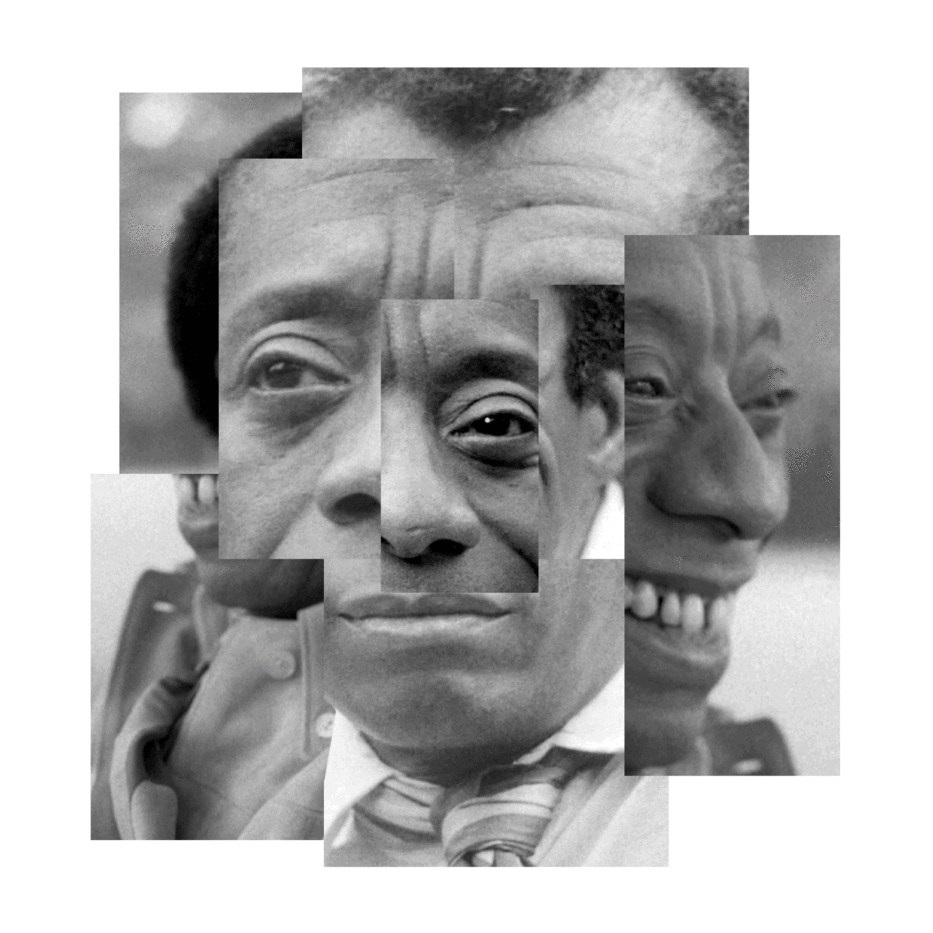

With Eddie Glaude Jr.’s Begin Again: James Baldwin’s America and its Urgent Lessons for Our Own, the recent surplus of James Baldwin features has grown another monograph larger. Begin Again quickly climbed bestseller lists, earning a number of glowing reviews — hardly surprising, given that, over these past few years, Baldwin has certainly been back in vogue. This summer, we may have reached peak Baldwin: Instagram was rife with the author’s quotations, and his books topped “anti-racist reading lists.”
Ta-Nehisi Coates is often credited with kickstarting the Baldwin revival. His 2015 bestselling epistolary memoir, Between the World and Me, mimicked the structure of the popular essay that comprises half of Baldwin’s The Fire Next Time (1963). In an open letter to his nephew, Baldwin sounds off on the apocalyptic consequences of American racism, while Coates reflects on the same ever-present force in an extended letter to his son. While much distinguishes Baldwin’s writing from Coates’, both brandish a mode of collective address, inhabiting the role of native informant and laying bare the inner life of racialized communities. Ultimately, both books provide pseudo-psychologized accounts of interpersonal race relations: Baldwin boils Black consciousness down to a state of fury while Coates diagnoses racists as “people who believe they are white.” Baldwin introduced the American reading public to these formulae, and Coates has helped ensure that we will stick to them.
Within the academy, we’ve seen an outpouring of Baldwin publications including James Baldwin and the Queer Imagination (2014), The Fire This Time: A New Generation Speaks About Race (2017), and James Baldwin in Context (2019). The Baldwin resurgence has extended to movie theaters and streaming services as well. In 2016, Baldwin’s unpublished Remember This House was delivered to contemporary audiences in the form of I Am Not Your Negro. Two years later, Barry Jenkins’s film adaptation of the Baldwin novel If Beale Street Could Talk opened to sold-out theaters. Most recently, Baldwin appeared on the first season of HBO’s Lovecraft Country: his voice emanates from the radio as the show’s central Black characters drive across the Midwest. Set during the Jim Crow era, the characters encounter segregated lunch counters, unfettered racists at gas stations, and an unemployment line composed entirely of African Americans. Listening to Baldwin restate and respond to the question “does the inequality suffered by African Americans hinder the American Dream?” brings the show’s sinister portrait of malt shop America into sharp relief.
What is it about Baldwin’s decades-old analysis that continues to resonate so thoroughly in the post-Obama period? Baldwin placed two foundational concepts at the heart of American racial inequality: a crisis of white racial identity and moral depravity on a national scale. This framework still guides public conversation about America’s past and future as it relates to race, surfacing in electoral candidates’ mantras about the “soul of the nation” and the self-help guides (think Ibram X. Kendi’s How to be an Antiracist and Robin DiAngelo’s White Fragility) that have headlined post-protest reading lists. Time and again, the focus on recalibrating the nation’s moral compass overshadows recognition of racial justice as a self-evident good.
An expansive historical chasm separates us from Baldwin, but his frustrated nationalism still informs a liberal imaginary now allergic to historical difference. No one has made this clearer than Coates, whose mourning and exhaustion comes as a result of his insistence on aligning contemporary racial inequality with a homogenous history of the changing same. From “The Case for Reparations” (2014) to We Were Eight Years in Power (2017), Coates repeatedly frames the racial animus that followed the Obama presidency as the zenith of centuries of racial discrimination, the tribal nature of which he treats as inevitable. His investment in the political promise of Black American cultural institutions, along with his reparations arguments, have buoyed his quasi-Black nationalist nostalgia. Despite his express concessions to the inevitability of white supremacy in the U.S., Coates has led a wave of public scholarship that chases contemporary racial justice by reminding America of its racist past.
The New York Times’s 1619 Project followed Coates’s lead, seeking to reconfigure the idea of America by coming to terms with its origins in the Atlantic slave trade. As its title suggests, 1619’s overarching conceit is the unthinkability of any idea of America that fails to foreground its enslaved beginnings in Jamestown, Virginia. Combining journalism, poetry, and popular history, it highlights the role of American slavery in shaping contemporary politics, culture, and everyday life, with implications visible to us in American sugar consumption, traffic in Atlanta, and the record-shattering reception of Lil Nas X. By documenting the numerous violations of the framers’ democratic social contract, 1619 attempts to set the record straight about America’s refusal to make good on its founding ideals. It purports to offer a more truthful U.S. history as a means of redeeming the nation — though its accuracy is up for contentious debate among academic historians.
The immediate relevance of this contentious history serves the urgency of our present politics. Countering the Trumpian campaign promises to restore the United States to its former glory, 1619 lays out the historical realities that put this perverse patriotism to shame. But, oddly, it shares a similar investment in the injury to our sacred national ideals. Its commitment to racial justice is hampered by a cruel optimism about what a rightfully realized idea of America could be.
The best liberal intentions have a long history of materializing in the form of redemptive projects like 1619’s. In fact, several historians have traced the absorption of anti-racism by romantic nationalism to the early years of the Cold War. After sponsoring the reconstruction of Western Europe after World War II, the U.S. aimed to further expand its ideological reach. It needed to beat back the Soviet influence that had crept into Central and Eastern Europe and centered the hypocrisy of American racism in its propaganda campaigns. Swedish sociologist Gunnar Myrdal had telegraphed the racial implications of the U.S./Soviet conflict before it even began. With philanthropic help from the Carnegie Corporation, his study An American Dilemma: The Negro Problem and Modern Democracy (1944) had framed racial inequality as the final obstacle to clear in the American ascent to geopolitical hegemony. In response, American state power took a number of measures to “address” widespread systemic racism (such as the Truman administration’s short-lived Committee on Civil Rights, 1946-1947), enacting a program of gestural anti-racism in order to legitimate its claims to global leadership.
The backstory to Myrdal’s sociological project typifies the tragedy of how we’ve come to talk about race and nation. A pioneer in sociological study, W.E.B. Du Bois had secured several institutional endorsements for his proposed Encyclopedia of the Negro over the course of the 1930s. Contrary to the ideals of gradual racial progress advanced by his institutionally supported peers, Du Bois intended to account for the material violences of race and capitalism in America and throughout the modern world. Carnegie Corporation president Frederick Keppel alleged that an “emotional factor” had compromised both Black and white American analysts, and organizations including the Rockefeller Foundation and General Education Board rescinded their support for the project. The Carnegie Corporation divested resources designated for Du Bois, reallocating them instead to Myrdal on the assumption that the Swedish native would be guaranteed-objective. Myrdal identified African American cultural pathology and distorted family life as obstacles to assimilation, which he painted as the ultimate answer to the Negro Problem. Following Myrdal’s work, philanthropic funds invested in furthering the multi-disciplinary study of race. Under the guises of multiculturalism and diversity, the institutional preoccupation with racial and national identity would persist for decades to come.
The power of these philanthropic foundations subsumed literary and academic worlds alike. As early as the 1930s, the Rosenwald and Rockefeller funds had cultivated a coterie of Black writers, intellectuals, and social scientists that the State Department could marshal in the promotion of its race relations programs. They supported Black social scientists Ralph Bunche and E. Franklin Frazier, along with writers such as Zora Neale Hurston, James Weldon Johnson, and Chester Himes. Yet by 1948, Black intellectuals could no longer depend on these philanthropic funds. And in response to the prosecutions that came with the Cold War’s second Red Scare, magazines like The New Leader, Commentary, and Partisan Review severed ties with many communist-affiliated writers en route to rebranding themselves as liberal-centrist publications.
Baldwin entered a literary scene heretofore dominated by the protest novel and the philanthropic institutions that sponsored it, the sociology departments that studied it, and the Black writers who produced it. Though Baldwin recognized the intended utility of what he regarded as social justice “tracts,” he found that they set a low bar for literary form, compromising the artistic integrity of the Western novel. Even in his essays, Baldwin imitated James Joyce, Henry James, and other Anglophone idols throughout the late 1940s and 1950s, most notably by adopting Emerson’s “national we” in essays such as “Strangers in the Village” (1953) and “The Discovery of What it Means to Be American” (1959). In “Everybody’s Protest Novel,” the 1949 essay that launched Baldwin to fame, he denounced the genealogy of social realism that had begun with Harriet Beecher Stowe’s Uncle Tom’s Cabin (1852) and culminated in Richard Wright’s Native Son (1940). Where protest writers took to the novel to level their anti-racist social critiques, Baldwin mobilized memoir to diagnose the causes and consequences of American racism. By synthesizing Myrdal-inspired sociological paradigms with conventional literary forms, Baldwin revolutionized the art of the essay.
Baldwin’s achievements, though, far exceeded categorical revisions on the relationship of race to literature. His non-academic essays made the study of race available to audiences outside the academy, inviting casual readers — for better or worse — to keep up with rapidly evolving conceptions of race to which Baldwin himself was a key contributor. Regarded as an unrivaled public intellectual for much of his career, it wasn’t until the decline of the Civil Rights Movement and the commercialization of Black Power in the 1970s that Baldwin fell out of favor in the public eye.
Though he was indebted to New York’s liberal magazines for his early success, Baldwin refused to publish with them by the 1960s. In his late writing he adopted the fiery tone of his Black nationalist critics, many of whom had grown exhausted with Baldwin’s sentimentalism and Martin Luther King Jr.’s commitment to nonviolence. After coming to fame as an opponent of protest fiction, Baldwin made an about-face with the publication of Tell Me How the Train’s Been Gone in 1968. The least successful novel of his career met all the criteria for “propaganda fiction,” according to its early reviews. And by many accounts, it accomplished little outside of parroting the radical politics of the Black Arts and Black Power movements. Baldwin persisted in articulating his newfound radicalism in the novels If Beale Street Could Talk (1974) and Just Above My Head (1979), but as far as Black liberation movements were concerned, his transformation seemed unfashionably late.
Decades after his death in 1987, Baldwin’s sermonic anti-racism is now in unprecedented demand. As Baldwin the radical convert has been embraced by mainstream media, his initially strained relationships with social movements and his conformity to institutional initiatives have been largely forgotten. To a significant share of committed anti-racists and well-intentioned allies, it’s Baldwin who personifies what feels like a once-in-a-lifetime movement. The echoes of post-Civil Rights Black nationalism that emanate from his late essays square well with this summer’s widespread sense that revolution was underway.
For this reason, it is hardly a shock that Eddie Glaude, chair of Princeton’s Department of African American Studies, confronts the current crisis by turning his readers to the instructive merits of Baldwin’s preacherly admonitions and insistence on spiritual renewal. The enduring appeal that Glaude finds in Baldwin’s anti-racist texts lies in their penchant for elucidating the inner workings of white racial prejudice and for pointing the way for the Black patriots who must endure. Absent from this uncritical invocation of Baldwin in Begin Again are the ideological shifts that shaped Baldwin’s writing from one decade to the next. Neglecting the complexities of Baldwin’s relationships to social movements and institutional power, Glaude imagines a consistent Baldwin whose steady moral vision is at once unique within his own social milieu and illuminating for ours. This allows Glaude to conveniently shore up his own patriotic moralism with Baldwin’s ostensibly prescient national critique. Baldwin wrote to the violent events of the 1960s, the end of the welfare state in the 1970s, and the austerity measures taken by the Reagan administration during the 1980s, all of which Glaude finds apt for the “aftertimes” marked by the election of Donald Trump.
Glaude takes the term “aftertimes” from Democratic Vistas (1871), Walt Whitman’s attempt to grapple with the social unrest that had obstructed the federal project of Reconstruction. He uses it to name white Americans’ resistance to social change following high points of anti-racist struggle, clarifying that he means something different from “backlash” or racial reaction. “In critical moments of transition, when it seems as if old ways of living and established norms are fading,” Glaude writes, “deep-seated fears emerge over loss of standing and privilege.” Put this way, “aftertimes” describes an atmosphere of racist counterrevolution, whereby white Americans cling to the myth of their supremacy in the moments in which it appears most threatened.
Glaude’s sleight of hand amounts to an outright reduction of America’s current democratic crisis to a problem of race alone, and he uses Baldwin to corroborate this conceptual move. Throughout, he offers stunningly definitive (and largely uncritical) claims about what Baldwin “knew” or “understood,” chief among them: “Sure, policy mattered. Power mattered. But in the end, for Jimmy what kind of human beings we aspired to be mattered more.” Apart from the presumption of deducing Baldwin’s inner life from his published essays, Glaude’s musings on the morality and identity of the nation preclude all discussion of economic stressors, labor relations, and demographic shifts. His meager effort to ground these claims in historical materialism results in the lumping of slavery, Jim Crow, lynching, police killings, prisons, Black ghettos, and failed schools into a continuous “pile of American shit.” Here, he draws on Baldwin again in order to defend the view that these ills have been perpetuated by America’s unwillingness to reckon with “who we are.”
Glaude’s recovery of Baldwin’s moralism also raises the stakes of the upcoming 2020 election. He frames the imperative to remove Trump from office as America’s opportunity to rectify a history of racist ills and chart a new racially just course. But this endeavor is complicated by the way Glaude positions electoral politics as secondary to moral aptitude and individual character. He writes, “changing laws or putting our faith in politicians to do the right thing are not enough [sic]. We have to rid ourselves, once and for all, of this belief that white people matter more than others, or we’re doomed to repeat the cycles of our ugly history over and over again.” At the same time that Glaude fixates on what he calls “the lie” of white supremacy, he invokes Baldwin’s prophetic promise that the racial regime in America can’t continue. With no clear picture of what an impending reckoning would look like, Glaude doubles down on Baldwin’s prediction that there will be hell to pay if our nation doesn’t atone for its racial sins. This eschatological vision marks the inadequacy of Glaude’s moral framework, leaving open the question: if the white supremacist fervor characteristic of the Trump universe has been routinely recycled since the Civil War, what does it mean to say that the nation’s racial sins will eventually catch up with it?
Yet Glaude is committed to the logical limitations of his address. He claims that America is in need of moral recovery and self-remaking, yet he concedes the deplorability of the white Americans who’ve chosen a distorted patriotism over economic justice and human rights. To frame this voting bloc’s frustration as anything other than racial nationalism would be to deny its purchase on a pugnacious pillar of the electorate. Following his claim that Baldwin finally learned that it’s up to racists to free themselves from the myths of their own supremacy, Glaude insists that we cease our attempts to sympathize with Trump voters who’ve felt increasingly left behind. “We cannot give in to these people,” Glaude declares, offering no clarification as to whom exactly he is asking to acknowledge the fundamental disregard for Black lives.
As far as his readership is concerned, Glaude insists that we forge communities based not on differences of identity but on bonds of love. Glaude wants his readers to come to terms with something like an ugly truth about America so as to salvage the democratic principles that have been undermined by anti-Black racism. This requires idealizing Baldwin as a seer whose moral guidance we should heed in order to realize a more racially just national future. But in the end, Glaude’s preachiness amounts to fervent restatements of the obvious (“the idea of America is in deep trouble”), and he struggles to answer the question of exactly how Baldwin’s meditations pertain to the present moment. He minimizes the particularities of our contemporary politics by likening them to as many events from Baldwin’s lifetime as possible, casting serious doubts onto the viability of long-term social change.
What’s actually instructive about the life and times of James Baldwin is how his work lived largely in literary circles and in lecture halls. His Lovecraft Country cameo excerpts a debate with William F. Buckley at Cambridge University in 1965, one of many televised performances that Baldwin shared with actors Marlon Brando and Sydney Portier and entertainers such as Harry Belafonte and Dick Gregory. Throughout the popular part of his career, Baldwin’s writing served a liberal establishment that stifled radical demands on institutions with abstract anti-racism and narratives of interpersonal racial progress. The striking similarity between the high point of Baldwin’s career and the moment of his resurgence is that racial justice is negotiated far too frequently on these terms. Liberal common sense demands an anti-racism aimed at fortifying Black identities and rehabilitating racist individuals, and it’s the promotion of these projects to which Baldwin has now so often been consigned. It is possible to cherish Baldwin as a canonical American writer while remaining critical of the liberal discourses to which he contributed. It’s Baldwin as a creature of these historically specific contexts from whom we have so much to learn.
Joel Rhone is a PhD student in English Language and Literature at the University of Chicago, where he specializes in African American letters after 1945.



